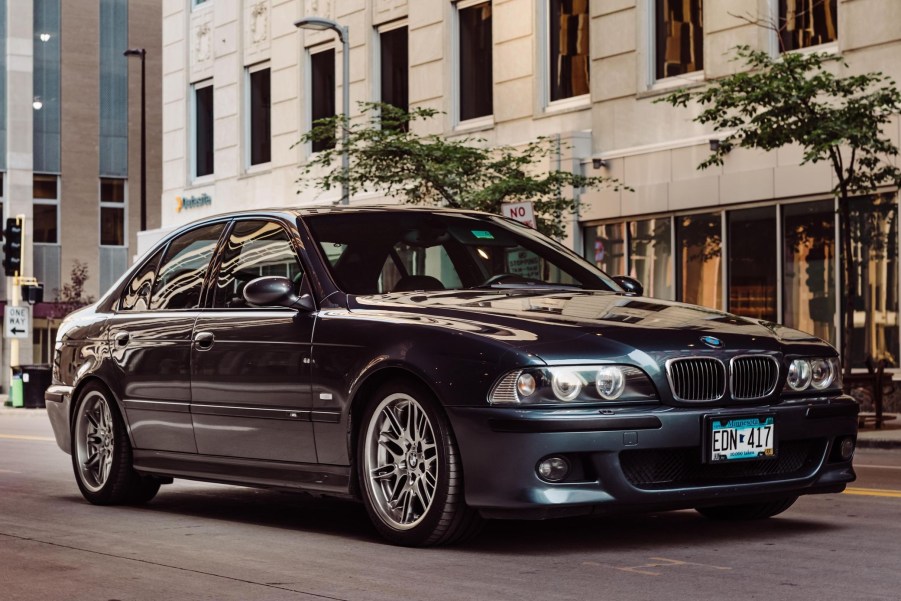
Cars & Bids Bargain of the Week: 2000 E39 BMW M5
From its E28 start, the BMW M5 has been a luxury sedan that can hang with supercars. And the latest M5 is no different, especially in high-power CS form. Getting a new one, though, requires coughing some serious cash. However, thanks to depreciation, used BMWs are significantly more affordable—and arguably more fun to drive than new ones. And this week on Cars & Bids, there’s a chance to own one of this super sedan’s high points: a 2000 E39 M5.
When it comes to luxury and driving fun, the E39 M5 “was peak BMW,” Hagerty says

For many, the late 1990s and early 2000s are “the golden age of BMW,” Hagerty reports. This was the age of the E38 7 Series, the ‘clown shoe’ M Coupe, and the beloved E46 M3. And it was also the era of the E39 BMW M5, often hailed as “the best-driving four-door ever built,” Road & Track says.
In contrast to the E28 and E34 models, the 2000-2003 E39 M5 doesn’t have an inline-six engine. Instead, it was the first M car with a V8: a 7000-RPM 4.9-liter ‘S62’ V8 based on the E39 540i’s ‘M62’ V8. The engine makes 394 hp and 369 lb-ft of torque, all of which goes to the rear wheels. And the only transmission is a six-speed manual linked to a limited-slip differential. That’s enough to let the E39 BMW M5 go 0-60 mph in less than five seconds, Hagerty says.
Besides the engine, BMW fitted the E39 M5 with upgraded suspension components, model-specific shock tuning, and thicker sway bars. The sedan also has a subtle rear lip spoiler, sport seats, and a light-up shift knob. Plus, a 2001 refresh gave the E39 M5 front parking sensors, more airbags, and a larger infotainment screen.
When it was new, the E39 BMW M5 competed with the Mercedes-Benz E55 AMG. While the E55 is faster, the M5 is the better sports sedan. The power delivery is linear and easy to control and the suspension offers both delightful and predictable handling as well as a supple ride, Evo reports. And the harder you drive, the better it gets, with increasing levels of feedback through the steering wheel. Plus, when you’re not carving corners, the E39 M5 is still a luxury sedan, with comfortable seats and a quiet interior.
Little wonder Hagerty calls it “the crème de la crème of early 2000s BMW offerings.”
There’s a 2000 model for sale on Cars & Bids

Compared to the European models, US-market E39 M5s came “highly optioned from the factory,” R&T says. And this 2000 model currently listed on Cars & Bids is a good example of that.
This 2000 BMW M5 doesn’t just have sport seats—it has heated sport seats. Plus, leather upholstery, navigation, rain-sensing wipers, headlight washers, an Alcantara headliner, and rear parking sensors. Also, automatic climate control, a six-disc CD changer, and a power sunroof.
In addition, this E39 M5 comes with several modifications:
- Dinan springs and rear sway bar
- Beastpower rear sway bar brackets
- Strut-tower brace
- Short shifter kit
- 16:9 navigation display
- 2001-facelift-style Depo taillights
- Umnitza Projector39 xenon headlights
- Front-end paint protection film

Despite its age, this 2000 BMW M5 has less than 106,500 miles on the clock. True, it has a few chips and scratches, plus cracks in the front bumper and rear diffuser. There’s also some underbody rust and steering wheel wear, plus the shift pattern is delaminating. However, it has service records and a zero-accident history. Plus, the seller recently changed the engine oil, fuel pump, and the rear Bilstein strut.
Will this 2000 E39 BMW M5 be a reliable bargain?

As of this writing, this 2000 E39 BMW M5 is listed on Cars & Bids at $11,250 with three days left in the auction. That’s more than $6000 below the fair-condition market average, Hagerty reports. And it’s a considerable discount from its original $72,420 sticker price.
As always, it’s recommended that potential bidders try to schedule a pre-purchase inspection before putting down money. That’s because while the E39 M5 isn’t quite the maintenance nightmare its successor is, the sedan has some trouble spots.
Pre-2001 examples lacked screws in their VANOS covers that caused early solenoid damage. And while the S62 V8 does consume some oil naturally, Car and Driver notes, pre-2001 cars’ piston rings exacerbated the issue. The engine also uses plastic timing chain tensioner guides, which degrade over time, and pre-2001 examples are more prone to carbon buildup. Furthermore, as with other modern BMW engines, the VANOS system solenoids need to be replaced from time to time.
That being said, while the S62 V8 isn’t necessarily the most reliable BMW engine, these issues aren’t deal-breakers. Using fully-synthetic 10W60 oil, as BMW recommended for 2001-2003 E39 M5s, partially resolves the consumption issue. Carbon buildup is a problem for many direct-injection engines, not just BMW’s engines. Modern tensioner guides are more robust, and the chains themselves are durable. Plus, while it’s not a BMW-approved repair, instead of replacing the entire VANOS system, rebuilding the system is a cheaper alternative, BMW Tuning explains. And this 2000 M5’s seller says that issue might have already been addressed.
So, while it’s not perfect, this E39 M5 has the makings of a true super-sedan bargain.
Follow more updates from MotorBiscuit on our Facebook page.


